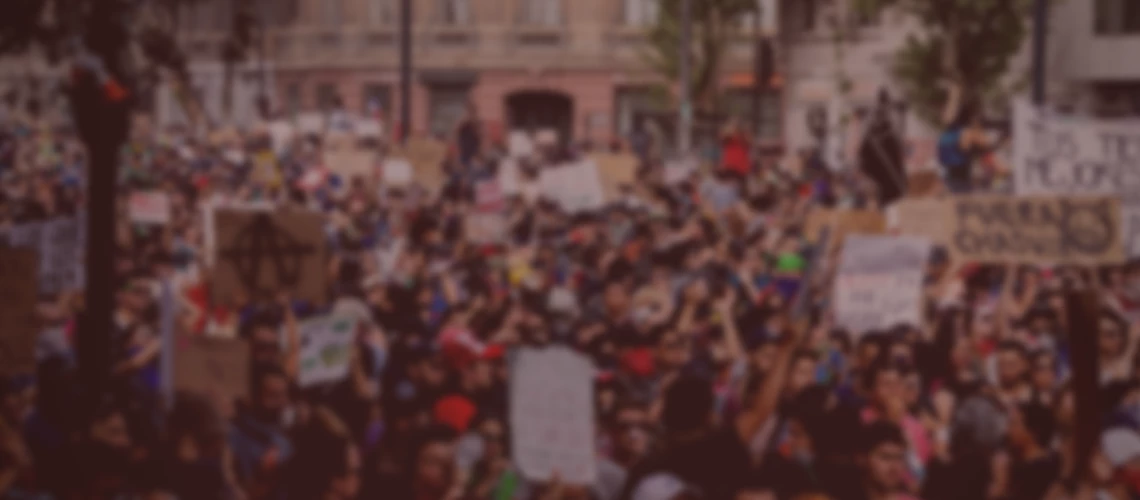 23/10/2019 Santiago de Chile / Photo: abriendomundo/Shutterstock
23/10/2019 Santiago de Chile / Photo: abriendomundo/Shutterstock
If you’re at COP25 in Madrid, join us for "Climate Change and Social Unrest" at the MDB Pavilion on December 7, 12:00-01:00 PM (CET).
In the last few months, states of emergency were declared in Chile, after an increase in metro ticket prices; and in Ecuador, after a reform of energy prices. In both cases, reforms were canceled after violent protests erupted. In France last year, the increase in the carbon tax was also canceled after massive protests by the gilets jaunes. In 2011, it was a spike in food prices that led to unrest and the toppling of several governments in North Africa.
These cases highlight how sensitive populations are to change in the prices of basic commodities like food, energy and transport. And for good reasons: these basic commodities represent a large share of the budget of most households and there is no way around consuming them: one needs to buy food, to heat homes in winter, and to go to work every morning.
This is the context in which most countries have committed to stabilize climate change. Doing so requires deep transformations in how we produce food, we consume energy, and travel to work or for leisure. Awareness and willingness to act to reduce carbon emissions and protect the climate has never been higher, but the challenge has never looked more daunting.
So how should they design climate action in this context? By acknowledging that climate action does not happen in a vacuum, but in a political context with pre-existing issues, social tensions, and policy objectives.
A first dimension to consider is ethical. There is a consensus that climate action should not negatively affect poor countries and people: the poorest one billion people on earth are responsible for less than one percent of carbon emissions and, historically, they have contributed nothing to the accumulation of CO2 in the atmosphere.
A lot of research and analysis has focused on this question recently, identifying practical solutions to make sure climate policies contribute to poverty reduction. For instance, solar home systems are particularly well suited to provide electricity to very poor people living in rural areas and can contribute to their escape from poverty. Efficient public transit helps poor people access better jobs and services. And revenues from a carbon tax or a fossil fuel subsidy reform can be used to boost social assistance. In a sample of low-income countries, replacing an energy subsidy by a universal cash transfer could provide net benefits the bottom 60 percent of the income distribution. When Indonesia successfully reformed its fossil fuel subsidies in 2005, it directed revenues towards social assistance: in order to protect the poorest, it created a monthly cash transfer that covered 35 percent of the population.
However, social protection is not a silver bullet. First, social protection systems are imperfect, and many poor households are not covered. And even if cash transfers compensate poor households in financial terms, higher fuel prices may have negative consequences, such as increasing the use of biomass, for cooking for instance, with dire consequences for health, and deforestation. Sometimes, targeted subsidies, by comparison, remain the best tool to help very poor people access modern, safe, and healthy energy. Going further, since the impact of the very poor on carbon emissions is often limited, it can sometimes be preferable to leave them alone, at least for the time being.
Moreover, reforms do not usually fail because they affect the poorest. Too often, the poorest have little influence on political decisions anyway. Instead, protests often originate from the urban middle class or from categories that are particularly affected by the reform, like taxi drivers or people working in energy-intensive industries. While they may not be part of the poorest segment of the population, and therefore not covered by traditional compensation mechanisms, they may still feel that the reform affects them unfairly and that they need support to cope with the shock. Recent research suggests that, in Ecuador, the combined reform of energy prices and increase in social protection spending would have benefited the poorest 40% of households; but the impact would still have been negative for the taxi, bus, and truck drivers who started the protests.
Spatial inequalities also matter. Rural people are often more dependent on fossil fuels than urban dwellers. In cities, suburbs are more exposed than city centers. Even a moderate spike in fuel or transport costs can be seen as unfair for middle-class households who have moved far from jobs (and public transit) in search for affordable housing. Deciles of the income distributions are abstract constructions, not real political entities. But when impacts are spatially concentrated on actual communities or socioeconomic groups, they can more easily get energized and organized.
The political economy challenge is also not only about fairness and ethics. A second dimension to consider is the political feasibility. Reforms need enough consensus to be implementable, and sometimes a reform needs to include complementary actions that are not driven by ethical considerations but by concrete political realities. Indonesia’s energy subsidy reform included targeted education support for civil servant, police, and soldiers, to boost the popularity of the reform and mitigate social risks. In countries with strong and influential energy-intensive sectors, for instance coal mining, specific action to facilitate the transition – and sometimes to compensate some of the actors may be necessary to make the reform possible.
People’s responses also depend on the narrative around the reforms, not only on the reforms themselves. For instance, carbon taxes have sometimes been framed as “sin taxes,” based on the polluter-pays principle. But for households who cannot afford to live close to a city center and are, therefore, dependent on cars for commuting or grocery shopping, the implicit moral judgment may appear profoundly unfair. There is nothing more unsettling than being punished for something you have no control upon. A more positive narrative, instead, signaling that part of the revenues will go to support transition green technologies or public transit, can make a carbon tax more palatable.
A third dimension is the political context in which they take place. In Chile or France, the financial impacts of the failed reforms were relatively small, making it difficult to anticipate the strong and sometimes violent opposition. The anger in the population’s response can only be understood if one considers the reforms not as the causes of the protest, but more as the triggers, in a context of pre-existing social tensions.
Like the effect of food prices in North Africa in 2011 or the impact of the drought in Darfur in 2003, the reforms in France, Haiti, Chile or Ecuador would not alone have created social unrest. Instead, broader concerns regarding the efficiency of government or the political response to inequalities were the real cause of the protests. Attributing social unrest to the specific reforms that triggered it – or even to an opposition to climate action, as some have done – would be a mistake.
What’s the solution? There is no one silver bullet. Instead, a few principles can guide policy design.
First, it’s not only about the policies themselves, but also about how they are discussed, designed, implemented, and monitored. Climate action needs an open and transparent framework, with clear objectives and real opportunities for stakeholders to comment, inform, and influence policies. Surprise changes are less likely to be broadly accepted than negotiated reforms.
Climate change also needs to be framed as a positive agenda and designed to contribute to broader policy goals, including development, poverty and inequality reduction, job creation, and any other important objectives that the population cares about. Where reducing inequality is a strong demand, then climate action can be designed to also deliver on that goal and framed as such. Where air quality, access to water and sanitation, or electricity reliability is an everyday issue, then climate action can be built to contribute to solving these problems.
It means that climate action plans – such as the Nationally Determined Contributions that are part of the Paris Agreement – cannot be designed independently of the national planning process and the design of economic and development policies. Instead, mainstreaming climate action into development plans would help create a narrative in which climate action support people’s short-term priorities and create policy packages that deliver on multiple goals.
The design of these policy packages needs to be pragmatic and realistic. Often, a carbon tax will be part of the package, since it is easy to collect (and difficult to evade…) and its revenues provide the resources needed to achieve many of today’s policy goals, such as funding universal access to infrastructure services or stronger social protection systems. In other places, a government may consider that the introduction of a carbon price, with its impact of energy, transport, and food prices, would create unmanageable political challenges and should be delayed.
In those cases, fortunately, there is more to climate action than carbon taxes. Better urban planning, investments in public transit, stricter energy-efficiency for new buildings and appliances, better technologies and practice for climate-smart agriculture, lower import tariffs for green products and technologies are examples of measures that can reduce carbon emissions, reduce the cost of living, and directly improve people’s quality of life.


Join the Conversation